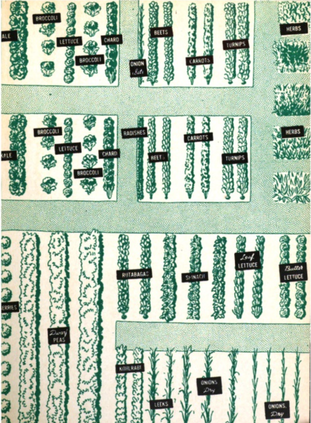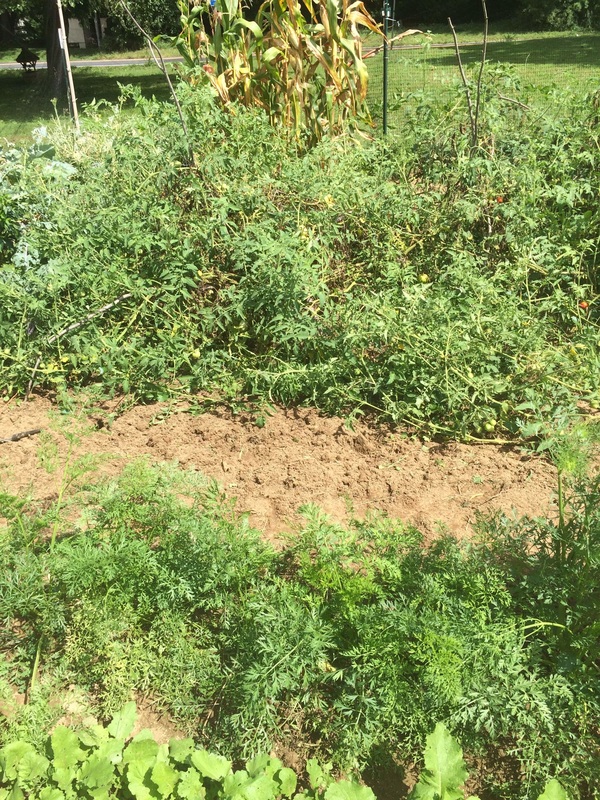Garden Ideal vs. Garden Reality
 Front paper, Sunset’s Vegetable Garden Book. (San Francisco : 1943). HathiTrust Digital Library.
Front paper, Sunset’s Vegetable Garden Book. (San Francisco : 1943). HathiTrust Digital Library. Dating back to the earliest garden magazines, readers of horticultural lit have been treated to pictures of perfectly trimmed beds, immaculate borders, orderly plantings, tomatoes staked out upright and proud, with lines drawn by rulers and nary a leaf out of place. No one publishes pictures of that weedy back corner, the stretch of broccoli completely decimated by pests overnight, the potatoes that were vibrant one day and gone the next, the rows of spinach planted that never came up . . . (Did you know soil temperatures above 75 degrees Fahrenheit can stop certain varieties' germinations? We learned this just recently.)
My summer story is a little different than standard depictions of gardens from World War II - or any other era. Just Friday I came across the visuals at left and nearly despaired of my garden. I sighed and went to the internet for a quick break from work, when I stumbled upon a blog post: My Garden Sucks and That's Ok. That's when I knew what I needed to write about this weekend. Still, one particular World War II quote came to mind as I surveyed the weedy wasteland at the start of some seriously heavy work and weeding:
For even though they have the best of intentions in the beginning, many people permit their own gardens to go to waste through carelessness, neglect, or ignorance.
-Florence Kerr, “Community and Defense Gardens, Presented at the National Defense Gardening Conference in Washington, D.C.,” December 19, 1941. RG 16 Entry 17 Records of the Office of the Secretary of Agriculture, General Correspondence, 1906-1970. Box 303 (1941) file "Gardens". National Archives at College Park, Maryland.
My Weekend To-Do List Was Not Modest:
- Rip out beans (old, eaten by bugs)
- Replant turnips/parsnips row
- Continue with setting mouse traps with peanut butter
- Dump all the seed packets that got wet in the rain and see if any germinate
- Pest treatment – make homemade spray? Investigate WW2 resources further
- Decide if moving our little greenhouse to VG plot in winter, if so, where; rest that soil???
Outside the Victory Garden:
- Rip out back bed weeds, fill in with seeds where zucchinis were, stake lone tomato there
- Weed & replant sad failed lettuce bed: cabbage back row, middle row arugula, front trim of spinach
- Start basil, chives in pot.
- Try again with eucalyptus & thyme cuttings so have indoors this winter
- Repot cacti, baby orchid, big orchid (need orchid soil though)
- Make a raised bed and plant garlic STAT. (How much would be a years supply?)
PLANS TO EXPLORE FOR NEXT YEAR
- Put a raised bed in lazarus bed where soil isn't draining well
- Mulch the shed-stair-corner for winter so we can plant with flowers next year
- Rain barrel possibility???
Results:
 Smartweed (Persicaria macula)- pest or bouquet?
Smartweed (Persicaria macula)- pest or bouquet? As is the way of the garden, along the way to accomplishing the things we did, more to-dos emerged: the creation of the bouquet at left, the realization that I could be making smudge sticks out of the mugwort (Artemisia vulgaris), ideas for pollinator-friendly plantings in under-utilized corners, and of course, more ideas for things to research and write about out in the garden. Here's to a week as productive and satisfying at work on the dissertation coming up!
Bonus: Delaware Gardening Resources (Try this at home!)
http://www.thedch.org/sites/default/files/pdfs/Content%20-%20Planting%20Calendar.pdf
http://www.ufseeds.com/Delaware-Vegetable-Planting-Calendar.html
http://www.almanac.com/gardening/planting-dates/DE/Newark
http://extension.udel.edu/lawngarden/master-gardener-volunteer-educators/delaware-garden-calendar/

 RSS Feed
RSS Feed